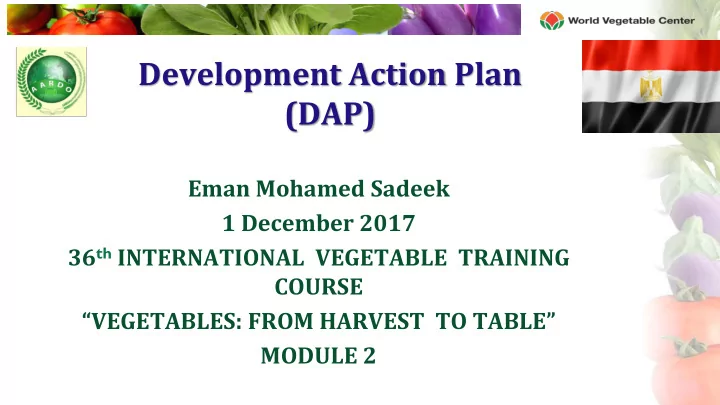

Development Action Plan (DAP) Eman Mohamed Sadeek 1 December 2017 36 th INTERNATIONAL VEGETABLE TRAINING COURSE “ VEGETABLES: FROM HARVEST TO TABLE ” MODULE 2
Personal Data Eman Mohamed Sadeek • • Assistant Researcher • Food Technology Research Institute, Agricultural Research Center. ➢ Education background • BSc Food Science & Technology , Faculty of Home Economic. • MSc Food Industries, Faculty of Agriculture. ➢ Main responsibilities • Evaluation of fruits, vegetables and its products via chemical, microbiological and sensory analysis • Sharing in the motherhood and childhood project, which aims to increase food awareness of rural women and sharing internal extension in Food Technology Research Institute.
Arab Republic of Egypt Northern east of Africa Location Sinai is bridge between Africa and Asia 1 Million Km 2 Surface-area Capital Cairo Population 104 million Official Language Arabic Borders Libya at the west Sudan at the south Palestine at the northern east Mediterranean Sea at the north Red Sea at the east
Hatshepsut Temple Akhmim Temple
Sharm El sheikh
Our organization
Three topics in module 2 that I found most useful • Fresh cut, water loss, browning & microbial control. • Vegetable Value Chain and Analysis. • Food processing and nutritional quality of vegetables & fruits.
Problem Crop and food manufacturing losses in Egypt • Egypt is a subtropical country. Its climate mainly suits the production of horticultural crops (fruit and vegetables) which play a very important role in Egypt's agriculture. • Large quantities of wastes are being left and disposal of these waste materials becomes difficult and pose serious problems, where they are considered a main source of microbial contamination and pollution.
• Grape , mango , potato , citrus and tomato are the most important fruits and vegetables which grown in Egypt. • Large quantities of these crops are widely processed to produce many products such as juices , jams , tomato paste, chips and concentrated syrups. They all contain a by-product from which can be recovered different high-added value compounds; among those ( Dietary fiber – Pectin- natural pigments)
Sources of contamination
Percentage of losses
Objectives Reduce contamination, pollution and diseases spread. Increase production of natural product such as natural pigments. Increase utilization of natural component as replacement of artificial components in food manufacturing.
Inputs Materials & Equipment Buildings Money Staff Transportation
Activities 2018-2020 Year Determination of nutritive value of some selected fruits and vegetable wastes Per season for each Varity Four varieties ( tomato pomace, citrus peel, potato and mango peel). Extraction & concentration of different component. Per season for each Varity • pectin from citrus peel • lycopene from tomato pomace • fiber from mango peel
Total budget Details 2018-2020 Materials & equipment 140000 staff 70000 Transportation 20000 Minor modifications 20000 Total 250000 EGP
Project benefits Reduce contamination and disease spread from crop and food manufacturing wastes. Increase using natural ingredient in food industries Increase the production of natural ingredients from the wastes of fruit and vegetable factories Developing the use of waste from vegetable and fruit during food processing.
Collaborators • Researcher Ministry of agriculture • Chemical analyst • Factories Ministry of industry • Quality engineers Food and drug administration • Food and drug administration control control
Challenges • Cooperation of factories with researchers. • The budget for laboratory analysis and extraction.
Recommend
More recommend